How to install a washing machine in the bathroom yourself
 The proper functioning of the SMA largely depends on the correct installation of the unit. It is important to choose the location of the device correctly and carefully study the instructions for connecting the machine to house utilities. Most often, users want to install a washing machine in the bathroom, because this is the place they find more convenient for further use of the washing machine. This room is characterized by high humidity, so it is necessary to follow certain rules when connecting the unit.
The proper functioning of the SMA largely depends on the correct installation of the unit. It is important to choose the location of the device correctly and carefully study the instructions for connecting the machine to house utilities. Most often, users want to install a washing machine in the bathroom, because this is the place they find more convenient for further use of the washing machine. This room is characterized by high humidity, so it is necessary to follow certain rules when connecting the unit.
We choose the place carefully
Before you independently connect the machine in the bathroom, you should determine the specific location where it will be installed. Despite the size of the room and its design, when choosing a site for SMA, certain conditions must be observed.
- The unit should be located as close as possible to house communications. This will allow you to connect the drain and water intake hoses without much effort. Of course, you can lengthen the hoses if necessary, but this will entail additional costs of money, effort and time.
- The machine must be placed near an outlet so that the power cord of the device can easily reach the connection point.
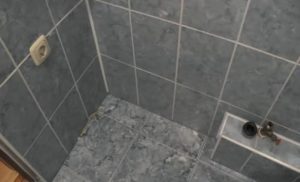 Using an extension cord is extremely dangerous and may cause electric shock to the user.
Using an extension cord is extremely dangerous and may cause electric shock to the user. - There should not be a lot of splashes, drops, or steam on the walls of the machine body. The equipment is not afraid of high humidity, but if you constantly water it with water, the washing machine will definitely fail.
- Foreign objects must not be installed on the unit; all of this is an additional mechanical load that disrupts the normal functioning of the device and leads to equipment failure.
- The washing machine should not restrict free movement in space. Firstly, this will bring inconvenience to family members, and secondly, it will increase the risk of causing mechanical defects to the body of the machine.
When the room is spacious enough, there should not be any difficulties in choosing a place to install the machine. You can select any of the free corners or an unoccupied part of the wall for it. In modern interiors, a separate niche often becomes a place for installing a machine.
If the bathroom has modest dimensions, the SMA can be located directly under the countertop with a sink, or under the sink, called a “water lily”. A washbasin of such an interesting shape will not extend beyond the body of the unit, thereby saving space in the room.
Getting ready for the installation process
When choosing a place for the washing machine, you must analyze the walls and floor in this area; they must be strong and straight. Reliable, dry and smooth surfaces will provide the necessary conditions for the normal functioning of the SMA. Damp walls will negatively affect the body of the unit, causing corrosion of the metal elements of the machine.
It is very important to pay attention to the floor covering; an uneven floor provokes increased vibration of the washing machine during operation, and, consequently, increased wear of all elements of the system.
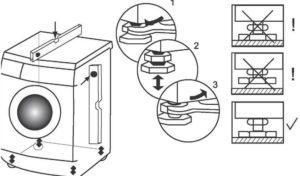 So what should you check? Firstly, the plane is examined for the presence of cracks, chips, and voids. Secondly, the surface is checked using a building level.If there is mold in the seams between the tiles, be sure to treat the area with special antifungal agents.
So what should you check? Firstly, the plane is examined for the presence of cracks, chips, and voids. Secondly, the surface is checked using a building level.If there is mold in the seams between the tiles, be sure to treat the area with special antifungal agents.
At this stage, it is recommended to consider how the unit will be connected to the water supply and sewerage system and measure the length of the hoses. It is very important to carry out all measurements accurately so that the automatic washing machine “fits” into the clearly defined place for it.
Increased attention should be paid to preparing the electrical point that powers the machine. The socket for the washing machine must be grounded and protected from moisture; it is necessary to install a three-wire device with 16 Amperes. The point should be connected directly to the panel; it is best to provide a circuit breaker for it. For added security it is better to use voltage stabilizer for washing machine.
The next step is organizing communication outputs. Their design directly depends on the chosen method of connecting the equipment; check out the available options and choose the most comfortable and appropriate one for your case.
Connecting to the water supply
This procedure can be carried out in several ways. The choice of connection option will depend on the existing skills of the person installing the washing machine. Consider the communications to which the connection will be made; if necessary, it is better to replace them before installing the machine. Let's look at the main methods by which you can connect the unit to the water supply.
If the pipes are old steel
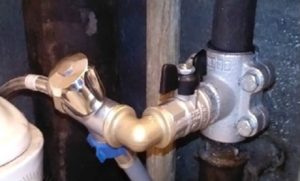 Under such conditions, you will have to tap directly into the water pipe. For this, a mortise clamp or a special crimp coupling is used.On top of the element there is a cavity with a thread, where the SMA water intake hose will be attached.
Under such conditions, you will have to tap directly into the water pipe. For this, a mortise clamp or a special crimp coupling is used.On top of the element there is a cavity with a thread, where the SMA water intake hose will be attached.
Additionally, with the coupling you can find a guide sleeve and a rubber gasket in the shape of a rectangle. The insertion is performed as follows:
- close all mixer taps and the valve that shuts off the water supply;
- clean and sand the surface of the communications where the gasket will be located until smooth;
- insert the guide sleeve into the mortise clamp and fix it in the cutout of the rubber gasket;
- attach the clamp to the water pipe using 4 bolts, tighten each of them in turn so that the elastic is pressed very tightly;
- using a drill with a drill bit with a diameter of 6 to 8 mm, make a hole in the pipe wall.
Place a small container under the clamp and open the faucet slightly, this will allow the water remaining inside to pour out.
When the liquid flows out, thoroughly clean the hole from metal shavings, attach a new faucet and examine the system for leaks. If the communications are made not of metal, but of metal-plastic, instead of a mortise clamp, a special element is used - a tee-fitting. The procedure will be even easier: after turning off the water in the riser, simply mark the connection location and cut off a piece of metal-plastic. Insert a fitting with built-in rubber seals into the resulting opening and attach a ball valve.
Connect to the mixer inlet
 The following method requires the user to place a special straight-through valve between the eccentric and the mixer. This faucet is equipped with a hose extension for the hot water system. This method is very popular due to its simplicity, the work is carried out quite quickly.However, all tubes and hoses are located in plain sight, as a result of which the aesthetics of the interior are compromised.
The following method requires the user to place a special straight-through valve between the eccentric and the mixer. This faucet is equipped with a hose extension for the hot water system. This method is very popular due to its simplicity, the work is carried out quite quickly.However, all tubes and hoses are located in plain sight, as a result of which the aesthetics of the interior are compromised.
You can carry out manipulations on a mixer made according to European standards in a few minutes. For this:
- disconnect the hose responsible for supplying cold water;
- screw a tap made in the form of a tee onto the eccentric;
- Connect the mixer hose into one of the holes, and the machine’s inlet hose into the second.
If the mixer on your bathtub is from a domestic manufacturer, then the algorithm will be slightly different. Once disconnected, unscrew the eccentrics and install a pass-through valve equipped with a special extension.
Connect the inlet hose to the faucet or tank
This method is the most practical and frequently used. The taps are installed on ready-made connections, which are used to drain liquid to the toilet flush tank, water heater or faucet. The outlet for the washing machine is mounted between the water riser and the faucet for the tank or mixer.
When connecting an element in the water heater area, carefully ensure that the pass-through valve is placed between the pipe and the valve, otherwise if the hot water supply is turned off, you will not be able to start the wash. The inclusion algorithm will be as follows:
- turn off the cold water;
- twist the tap responsible for its supply;
- take a tee tap, wrap the external thread with FUM;
- screw the part in place of the removed one;
- connect the hose from the mixer to one hole, the intake hose of the automatic machine to the second.
It is not difficult to carry out the work yourself; the main thing is to carefully study the basic installation rules and strictly follow the algorithm of actions stated in the instructions. Don't forget to follow safety precautions.
Organization of drainage
Draining waste water from the tank is one of the main functions of any SMA, so it is very important to provide the drain pump with the ability to clean the machine of excess water. The pump must quietly discharge the waste liquid without additional loads in such a way as to avoid its return into the unit system. To do this, you must correctly connect the washing machine to the sewer.
Simple waste disposal
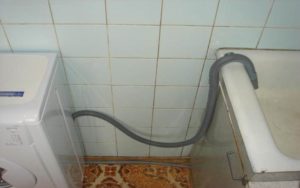 This method is the simplest, however, not entirely user-friendly. The principle of operation of the drainage system in this case will be primitive: one end of the hose is attached to a special hole on the body of the machine, the other is directed to the sink, bathtub or toilet.
This method is the simplest, however, not entirely user-friendly. The principle of operation of the drainage system in this case will be primitive: one end of the hose is attached to a special hole on the body of the machine, the other is directed to the sink, bathtub or toilet.
This method has one advantage - minimal time and effort. On the contrary, there are many disadvantages. Firstly, the drain hose is not securely fixed, so there is a possibility that it could fall and flood the room with dirty water. Secondly, you cannot use plumbing during the washing process. Thirdly, the waste liquid contaminates the surface of the bathtub and sink; this method of discharging water is unhygienic.
We connect to the side fitting of the siphon
If the washing machine is located in close proximity to the washbasin, the drain pipe can be connected to a siphon. The regular siphon will have to be replaced with a special one equipped with an additional pipe. Then simply attach the tip of the washing machine hose to the nozzle. The outlet is located in the upper part of the structure and at a slight angle, so waste water from the sink will not enter the drain system of the machine.
If we talk about the disadvantages of this method, there are two of them: the possibility of an unpleasant odor from the sewer system getting into the tank of the machine (to avoid this, it is recommended to use a water seal), and the likelihood that with excessively strong pressure, the waste water will not go into the sewer, but will rise into the sink and overflows over the edges.
We connect directly to the sewer
This method, although the most labor-intensive, is significantly superior to the previous ones in reliability. What needs to be prepared? A tee of the required diameter, having an oblique outlet and a check valve for the SMA. One part of the valve is connected to the drain pipe, the second, through a tee valve, is attached to the sewage system.
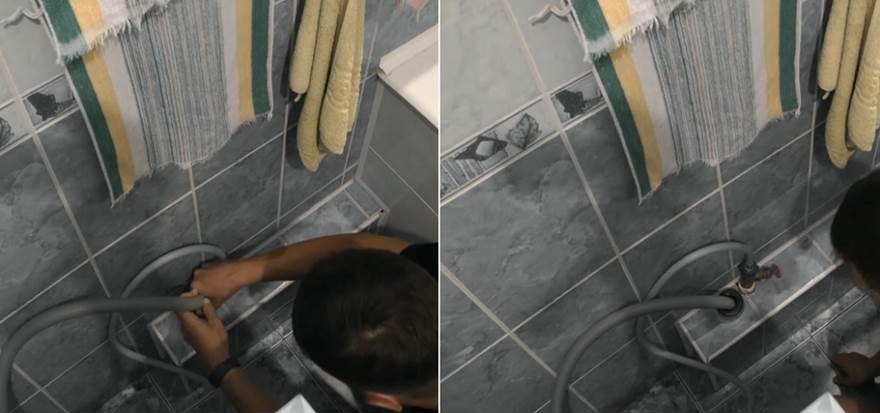
The inlet for the drain hose should be at a slight angle and located from top to bottom, this will prevent drains from plumbing fixtures from entering it, which can emit a nasty smell.
Description of the installation process
To begin with, the SMA must be freed from the manufacturer's packaging and the locking bolts that prevent the drum from loosening during transportation must be removed. It is very important not to forget to remove the stoppers; they can lead to failure of the chassis. You can unscrew the bolts using an open-end wrench. They are pulled out of the washing machine body along with the bushings, and plugs specially provided for this are inserted into the resulting holes.
The locking bolts must be preserved throughout the warranty period of the automatic machine, as well as in case you need to transport the unit for personal purposes.
- Place the SMA in the chosen place, and place a level on the upper wall of the case. If the equipment is not level, you should adjust it according to the level of its legs.There is no need to place the washing machine close to the wall, as well as furniture and plumbing fixtures, if they are located on the sides of the unit, be sure to leave a small gap.
- Pull the machine forward a little, this will make it easier to connect it to the communications.
- Connect the drain and inlet hoses to the house utilities by choosing any of the methods described above.
- Thread all the hoses into the specially provided recesses of the washing machine, this will prevent them from kinking.
After all the actions have been completed, the unit moves to its original position, is installed in a permanent place, and is again adjusted for level. In the end, all that remains is to plug the machine into the network and check its functionality by running the test mode.
First launch
When starting the test program, be sure to take the technical data sheet of the device and keep it in front of you. It will be needed for data verification. The test run does not involve loading laundry into the drum; it only involves water and detergent.
To begin with, the water intake into the SMA tank is turned on. It is necessary to detect the time of filling the drum to a certain point. Be sure to inspect the systems for leaks, and if any are found, drain the liquid and carry out work to seal the problematic connections. If there are no emergency leaks, check the unit further. Heating of water to the specified temperature should occur in 5-7 minutes. Check the measured time with that specified in the technical data sheet.
During normal operation, the washing machine should carry out all operations silently; strange creaks, knocks or rustling noises during the water heating stage indicate a problem in the system.
If the machine functions properly, almost silently, carry out a further test, examine other functions and capabilities of the washing machine, including the functionality of the drainage system. At the end of the mode, look again at all the tubes, connections, walls, floor covering around the device - everything should be dry.
Possible problems
It happens that after a test wash, all connections and tubes of the device remain dry, but there is water on the floor. This can happen if the garbage filter is not screwed in completely. It is located at the bottom of the machine, behind the false panel or in a special hatch for the garbage filter. By fixing it more tightly, you can get rid of this problem.
If the washing machine vibrates, rattles and sways a lot when operating in the “Spin” mode, it may be installed unevenly, or the problem may be due to an unsuitable floor covering. Another reason for this could be poorly secured counterweights. If the machine is new, then it is better to call a specialist to eliminate the manufacturing defect, but when the warranty period has already expired, you can tighten the counterweight bolts with your own hands by removing the top housing cover.
If all the installation rules have been followed, but the washing machine produces serious errors, for example, it does not turn on, does not start washing, does not adjust the parameters of the selected mode, it is better not to “climb” deep into the unit and find out the reasons for this, but to return the machine to a service center using a warranty card .
Interesting:
Reader comments
- Share your opinion - leave a comment
Categories
Washing machine repair


For buyers

For users

Dishwasher

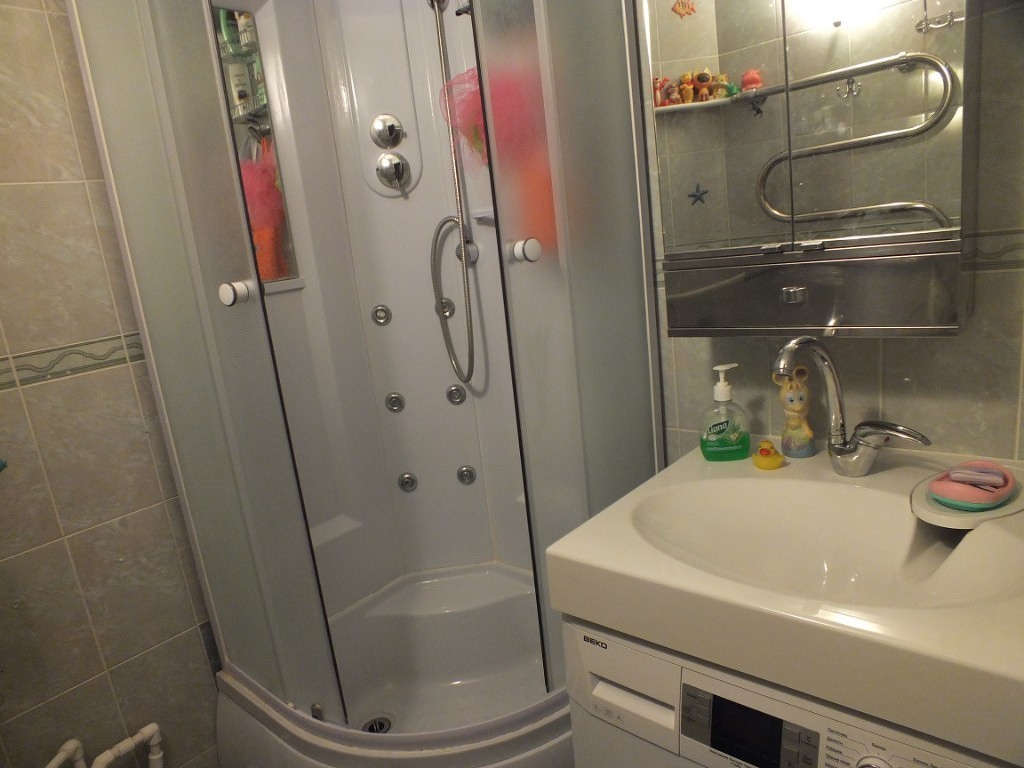

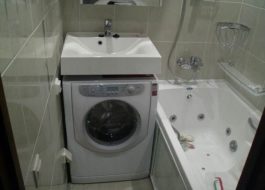

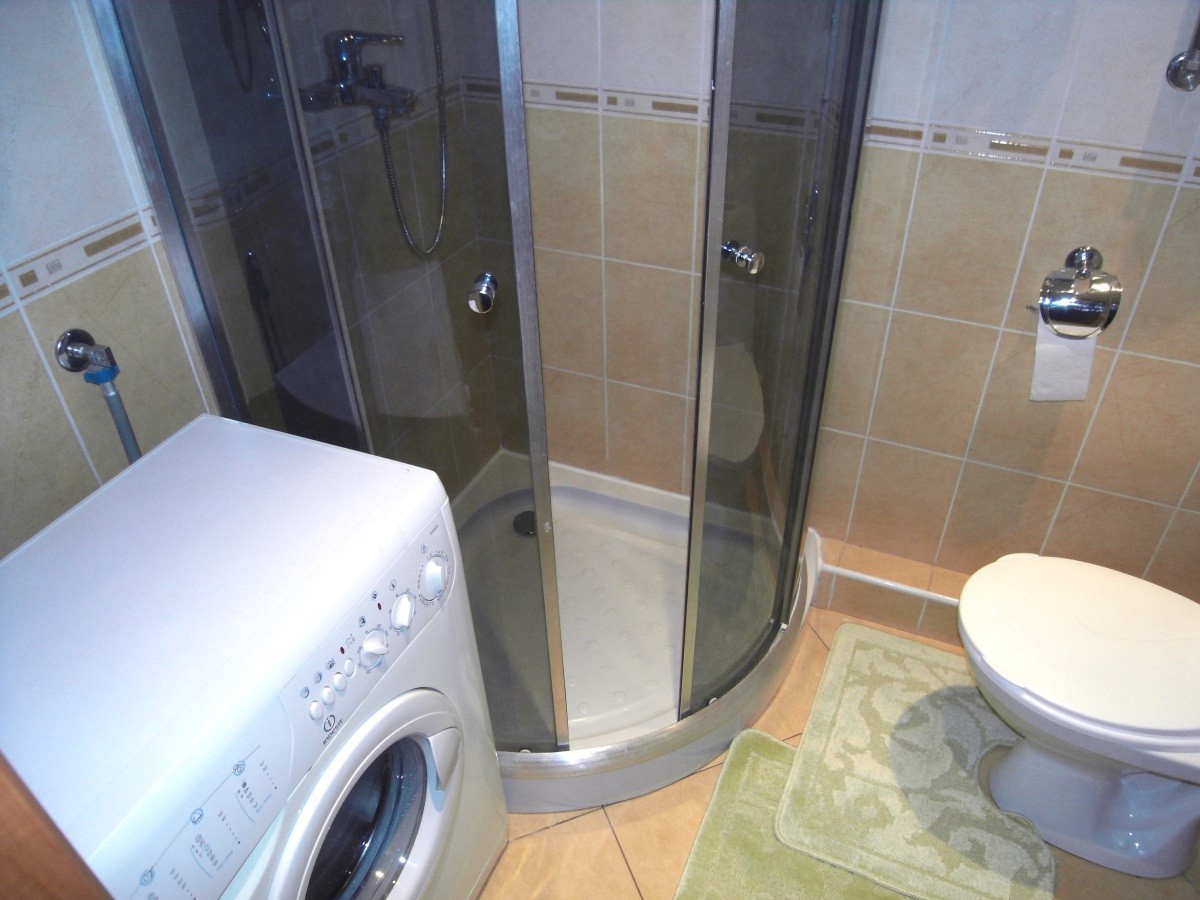
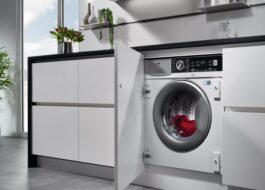










Add a comment